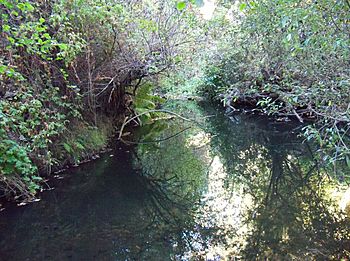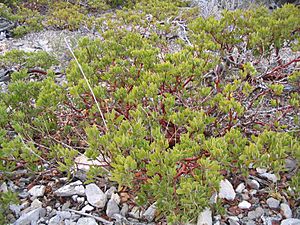Carbonera Creek facts for kids
Quick facts for kids Carbonera Creek |
|
|---|---|

Where Carbonera Creek meets Branciforte Creek.
|
|
| Country | United States |
| State | California |
| Region | Santa Cruz County |
| Physical characteristics | |
| Main source | Santa Cruz Mountains 37°03′02″N 122°00′45″W / 37.05056°N 122.01250°W |
| River mouth | United States |
Carbonera Creek is a stream about 10.2 miles (16.4 km) long in Santa Cruz County, California. It eventually flows into the San Lorenzo River.
This creek starts high up in the Santa Cruz Mountains. It then flows mostly towards the southwest. The city of Scotts Valley is located within the area drained by Carbonera Creek. Its main helper stream to the north is Bean Creek.
Carbonera Creek joins another stream called Branciforte Creek in Santa Cruz. Branciforte Creek then flows into the San Lorenzo River. Finally, the San Lorenzo River empties into the Pacific Ocean at Monterey Bay, right near Santa Cruz.
Carbonera Creek flows all year round. The area it drains, called its watershed, is about 7.4 square miles (19.2 km2). A smaller part of the creek, called the West Branch, is about 1.4 miles (2.3 km) long. This branch goes under roads and through tunnels. It joins the main Carbonera Creek just south of the State Route 17 highway. Carbonera Creek is the most important water feature in Scotts Valley. It runs through the western part of the old Santa's Village area and right through the middle of town.
Contents
Where Carbonera Creek Flows: Topography & Land

The land around Carbonera Creek changes a lot. The lowest parts of the valley are about 500 feet (152 meters) above sea level. The highest hills and ridges in the watershed reach about 1,123 feet (342 meters) high.
Water Flow & Rainfall in Carbonera Creek
The amount of rain Carbonera Creek gets each year varies. It usually ranges from 85 to 120 centimeters (about 33 to 47 inches). Most of this rain falls between November and April.
Carbonera Creek usually flows at an average speed of 0.8 to 1.0 cubic feet per second (0.02 to 0.03 cubic meters per second). Bean Creek, a nearby stream, flows a bit faster, averaging 3.0 cubic feet per second (0.08 cubic meters per second). However, the water flow in both creeks changes a lot with the seasons. During the dry summer months, the water levels drop quite a bit.
Animals & Plants: The Ecology of Carbonera Creek
The areas right along Carbonera Creek and its smaller streams are home to many plants. This is called a riparian zone. It's mostly filled with trees that lose their leaves in the fall. These trees can survive because there's fresh water all year.
- Trees you might see:
- California bay laurel
- Boxelder
- California sycamore
- Black cottonwood (Populus trichocarpa)
- Bigleaf maple
- White alder
- Different kinds of willows (Salix spp.)
The roots of these trees are important because they help stop the soil from washing away. Their thick leaves provide food and shelter for many birds and mammals. This makes the area a great home for wildlife. The dense plant cover also gives animals a safe place to have their babies.
- Other plants along the creek banks:
- California blackberry (Rubus vitifolius)
- Himalaya blackberry
- Poison oak (Rhus diversiloba)
- Naltic rush (Juncus balticus)
- Redwood sorrel (Oxalis oregana)
- Snowberry (Symphoricarpos rivularis)
- Coastal wood fern (Dryopteris arguta)
Unique Plant Communities in the Watershed
The Carbonera Creek area also has a plant community called Northern coastal scrub. These plants are found in scattered spots, usually on windy, open areas with thin, rocky soil.
- Plants in this community include:
- California sagebrush (Artemisia californica)
- Toyon (Heteromeles arbutifolia)
- Coyote brush (Baccharis pilularis)
- California yerba santa (Eriodictyon californicum)
- Different types of manzanita (Arctostaphylos spp.)
One very special and rare group of plants found here is the Maritime Coast Range Ponderosa Pine forests. This unique forest grows only in coastal Santa Cruz County. It's found in a part of the Carbonera Creek area in Scotts Valley, on the slopes of Mount Hermon. The soil here is sandy and doesn't hold much water. This means that trees like Coast redwood or Douglas fir can't grow well here.
However, the Ponderosa Pine (Pinus ponderosa) can handle these dry conditions. This forest also has some rare species of plants, like the Bonny Doon manzanita (also called silver-leaved manzanita) and the endangered Ben Lomond wallflower (Erysimum teretifolium). There are also two types of endangered insects that live in this special forest.
Fish in the Creek
The waters of Carbonera Creek are home to fish like steelhead (Oncorhynchus mykiss irideus) and Chinook salmon (Oncorhynchus tshawytscha). These fish travel up the San Lorenzo River and its branches, including Carbonera Creek. They come to Carbonera Creek to lay their eggs in the gravel, especially downstream from the old Santa's Village area.



